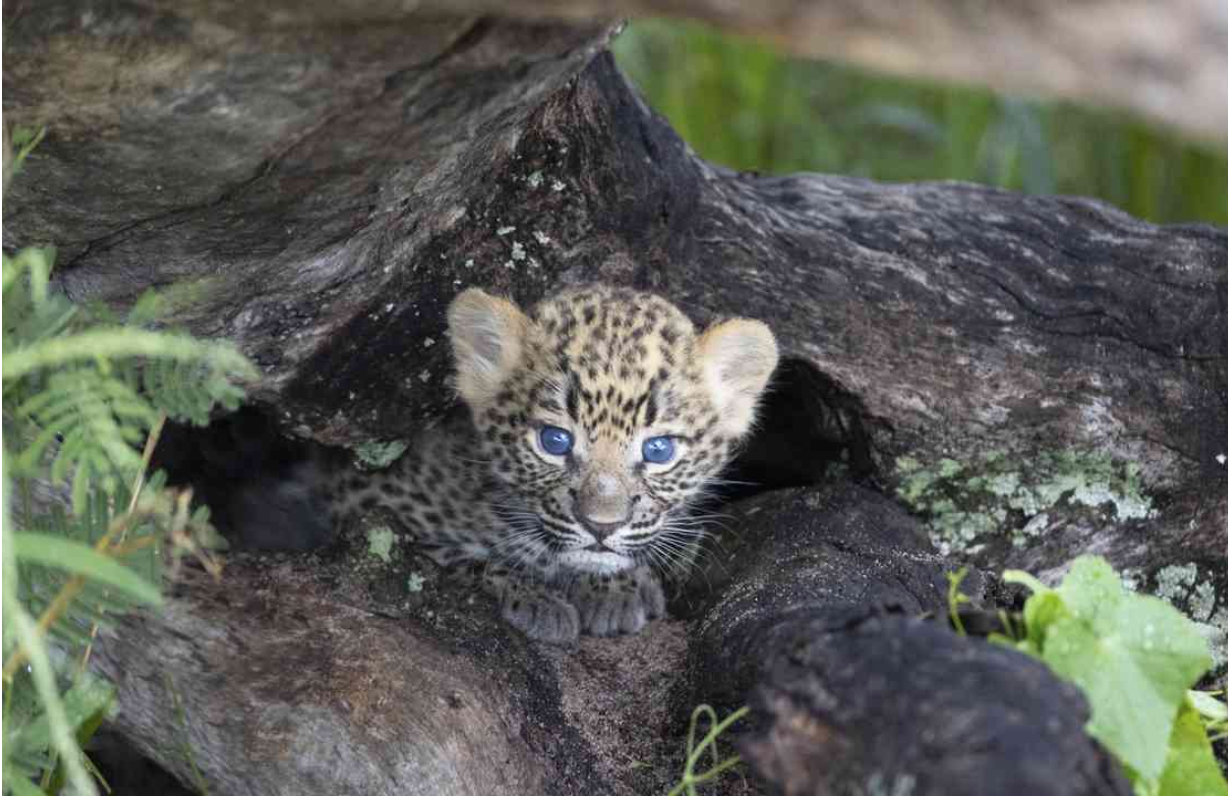Suzi Eszterhas is an award-winning wildlife photographer best known for her work documenting newborn animals and family life in the wild. She is also a great friend of Wilderness Safaris and has spent much time on the magnificent Hunda Island within the Jao Reserve, documenting the famous Tubu Camp leopardess.

Image by Suzi Eszterhas
Having lived in a bush camp in Africa for three years, and photographed wild animals on all seven continents, Suzi has accumulated scores of adventure stories during her prolific career. She has hugged a baby whale, swum with sloths, fended off curious grizzly bears, had hyaenas chew on her engine, insects lay eggs in her feet, was chased by a green mamba, and has hand-raised and released an orphaned serval.

Kambango Sinimbo and Suzi Eszterhas
Suzi spent time recently at Tubu Tree to photograph the Tubu Camp Female’s newest cub and was treated to arguably her best experience to date!

Image by Suzi Eszterhas
The Tubu Camp leopard lives in the Okavango Delta’s Jao Reserve. In the heart of her territory is Tubu Tree Camp, a small and luxurious, but low impact, safari camp on Hunda Island. The Tubu Camp Female grew up around the camp and is regularly spotted on game drives on and around the island.

The Jao Reserve is an Okavango haven, safe from poachers and vehicle crowding. This leopardess grew up around safari vehicles behaving responsibly, and having never been harassed, she trusts vehicles and is the most relaxed leopard I have ever worked with. In addition, she is very used to camp and staff activity and is not threatened by it, a truly habituated leopard. She is often seen at night on the boardwalk near the tents, but has never bothered people and simply jumps off and slinks away into the bush if anyone comes across her path. She occasionally makes a kill inside the camp.

Image by Suzi Eszterhas
Leopard mothers of newborn cubs are notoriously secretive, but the Tubu Camp Female, with her relaxed and trusting nature, has allowed me to see and photograph her for over two years now. In 2018 I started following her with her then-litter of two females for 18 months as they grew. Both these sub-adults are now still within the reserve and thriving. I recently returned to Tubu Tree Camp right after she gave birth to her new litter – a single male cub – and to photograph him as young as one week old.

Image by Suzi Eszterhas
Leopard mothers with young cubs can move them often to make sure they are safe from predators, sometimes choosing a new den every three to four days.
One morning, after we had lost track of the Tubu Camp Female for a couple of days, I was out on a game drive with my guide, the amazing Kambango Sinimbo. Kambango found her tracks around camp, but we had not been able to identify the location of her new den. While out tracking we received a radio call from the camp manager alerting us to the fact that a staff member had “found a leopard cub in the camp bathroom/loo with a view”.

Image by Suzi Eszterhas
Kambango laughed and we both assumed that the staff member had mistakenly found a genet. Genets are animals that live in the camp and are small and similarly spotted; to the untrained eye, a genet could look like a cat and even a leopard. We started back to camp, expecting a good laugh, but then another radio call from the manager. “Um, I’ve just had a look myself and it definitely looks like a leopard cub”. Though I took this call a little more seriously, I was still expecting to see a genet. Kambango, more convinced by this second call, said to me, “Grab your camera!”.

Image by Suzi Eszterhas
We arrived at camp and went straight into the loo with a view to investigate. And there on the floor, behind the sink, curled up against the wall was a tiny, furry ball of spots. I could hardly believe my eyes, it was indeed the leopard cub we had been looking for! I took a few seconds to snap some photos of the tiny, two-week-old cub – which was old enough to perceive me as a threat and opened his mouth in a silent hiss. Kambango and I quickly decided to leave, so as not to stress out the cub, and also because we had no idea where his mom was.

Image by Suzi Eszterhas


Even the most relaxed leopards can be ferocious when something or someone comes close to their young. And now, she had claimed the bathroom as her new den, and we were standing right in the middle of it.
In awe we drove away to park at a safe distance, to wait and watch for the mother’s return.

Image by Suzi Eszterhas
Kambango and I discussed at length why the mother would do such a thing. Undoubtedly this leopard felt safe in camp and did not see people as a threat, but to actually hide her cub in the bathroom? Kambango, a Tubu Tree Camp guide who has known and tracked this female since she was two months old, stated, “The camp is part of her territory. This side of camp has no guests at the moment so it is very quiet, and it probably seemed like a safe place to hide her cub. Behind the vanity basin, it is dark and den-like. Also, there were lots of lion tracks around camp the night before.
Lions are a huge threat to leopards and their cubs. With cub mortality rate at over 50%, a leopard mother has a big job to successfully raise a cub to adulthood. This includes the critical act of properly hiding the cub when it is tiny and helpless.

Image by Suzi Eszterhas
Cathy Kays, the owner of Tubu Tree Camp and concessionaire of the surrounding Jao Reserve, states, “We’ve had leopards bring their cubs in to live in the camp environment before, but moving a newborn into the Tubu guest bathroom is a new one, even for me. I guess she is called the Tubu Camp Female for a reason. This adds a new dimension of caution into camp operations”.

Image by Suzi Eszterhas
Management closed off this side of camp until the leopard mother returned. After waiting a few hours in a vehicle at a distance, Kambango and I watched the Tubu Camp Female come into the camp, walking stealthily along the boardwalk. She took some time to relax a bit by the camp swimming pool, having a drink and monitoring her surroundings, and then sauntered up to the bathroom. We could hear her making a quiet contact call to her cub as she entered the bathroom.

Image by Suzi Eszterhas


Moments later she reappeared on the boardwalk with the tiny cub in her mouth and carried him safely to another place, this time to a more typical den site – a tall tree outside of camp with a hole in the middle of the trunk where she could safely hide him from predators.
Footage by Suzi Eszterhas
This experience is undoubtedly the most bizarre of all days in the field, in my 20-year career photographing baby animals all over the planet. Though I am relieved that the mother moved the cub to a proper den site, I also feel blessed that I was able to witness such a special event. For an animal to feel so safe around people that she would move her cub into camp – in the bathroom no less – is extraordinary and almost unheard of. Every day we are bombarded with the tragic news about wildlife all over the world, so this experience was truly a ray of light and testament to the amazing conservation work being done within the Jao Reserve.
To see more phenomenal photos by Suzi Eszterhas and learn more about the wonderful work she does, you can follow her on Facebook and Instagram.


Written and Photographed by Suzi Eszterhas

